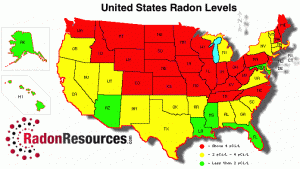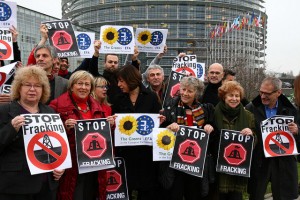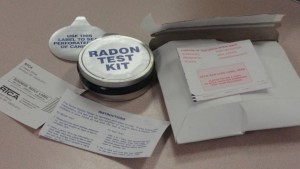A new report from researchers at John Hopkins university lends credence to legislation being pushed by assemblywoman Linda Rosenthal and senator Diane Savino in New York. Their proposal mandates that all natural gas being sold in the state cannot exceed safe radon levels.
More recently, the prevalence of radon gas has come under the public eye in all forms, including those not generally considered — such as through natural gas reserves.
Since radon is a naturally occurring radioactive gas, the most common way it enters a home is through cracks in the foundation, walls and flooring. The gas is released when common elements in soil and rock — such as Uranium — under the surface, undergo radioactive decay. The dense gas can seep into homes and structures, collecting in highly concentrated amounts.
What Effect Does Elevated Radon Gas Have on Our Health?
Radon is the second leading cause of lung cancer in the US, according to the Environmental Protection Agency (EPA).
 It is responsible for the deaths of more than 21,000 each year, all of whom were affected by radon-induced lung cancer.
It is responsible for the deaths of more than 21,000 each year, all of whom were affected by radon-induced lung cancer.
Radon gas is a bigger issue than most would like to admit. Many even grow irate when they hear that it’s a potential problem. People are quick to dismiss the idea of an invisible and deadly gas, regardless of warnings and years of research into the matter.
A long list of major health organizations warn that reducing exposure to radon gas is imperative to one’s health. Some of those organizations include:
- American Medical Association
- American Lung Association
- U.S. Surgeon General
- Centers for Disease Control and Prevention
- U.S. Environmental Protection Agency (EPA)
- World Health Organization
What Did the John Hopkins Team Find During Their Study of Elevated Radon Gas?
The John Hopkins team, led by Joan A. Casey, reports that radon levels have increased in the state of Pennsylvania ever since hydraulic fracturing of natural gas (or fracking) has begun under the surface.
According to the team, they found “a statistically significant association between proximity to unconventional natural gas wells drilled in the Marcellus shale and first floor radon concentration in the summer,” which suggests “a pathway through outdoor ambient air.”
 The point here is that unconventional methods for collecting natural gas — such as fracking — may increase exposure to radon gas. These concerns apply to both horizontal drilling and hydraulic fracturing. Please keep in mind, this is not an exact science.
The point here is that unconventional methods for collecting natural gas — such as fracking — may increase exposure to radon gas. These concerns apply to both horizontal drilling and hydraulic fracturing. Please keep in mind, this is not an exact science.
Further studies must be conducted to discern why the abundance of shale wells might have contributed to elevated radon gas levels in the state of Pennsylvania. Furthermore, future studies will need to be conducted to understand how to control such exposure to the deadly gas.
So, by now you’re probably asking how this news is relevant to New York? Many residents of the state use natural gas in their homes for cooking or to produce heat. Little do they know, they might be inviting the invisible gas inside their homes. In reality, this issue relates to anyone who uses natural gas in their home — no matter where they reside.
The proposed New York senate bills A778-2015/S3414-2015 are designed to prevent a higher death count due to the increased exposure to radon and other technologically enhanced naturally occurring radioactive materials (TENORM).
The bills may — or may not — pass, but that’s not what we’re getting at here. We’re glad to finally see legislation making the rounds that weighs-in on the dangers of elevated radon gas. Hopefully, more proposals will soon follow that help protect us from the dangers of this invisible killer.
Read the original story at Huffington Post.
Should You Test Your Home for the Presence of Elevated Radon Gas?
In the meantime, we recommend that all homeowners and renters have their residence tested for elevated radon gas.
 According to Mark Hudson, an expert in the field of oil and gas, “testing for radon is quick, inexpensive – and, given the potential volatility of the discussion, invaluable.”
According to Mark Hudson, an expert in the field of oil and gas, “testing for radon is quick, inexpensive – and, given the potential volatility of the discussion, invaluable.”
We definitely agree with Hudson.
You can pick up a DIY radon testing kit at any local hardware store or online for relatively cheap – $10 -$20. If you don’t feel like testing your home yourself, you can hire an experienced professional or certified radon contractor to do it for you. If elevated radon gas is discovered in your home, you’ll need to look into radon mitigation.
We recommend testing twice a year, and the best times to do that are winter and summer months. This is primarily because during that time you’re less likely to open windows and doors to the outside — you need to minimize air flow at all times while testing. You can find more information about radon testing here.
If you do discover elevated radon gas levels in your home, there’s no need to panic. They can be reduced through mitigation and monitored with further testing. Radon gas actually does more damage to your health over an extended period of time. Long-term exposure is what you need to be most concerned with. Naturally, that means the faster you have your home tested and take action — if need be — the faster you can secure your family’s health.


